Country guides

Things to do in St Maarten and St Martin
Each year hordes of tourists flock to Sint Maarten and Saint Martin for the beaches. Long Bay offers peace, quiet and perfect sunsets from luxury resorts, while Anse des Peres is a family friendly affair in the northwest, with legendary Full Moon parties at Kali's Beach Bar.
Known as the Saint-Tropez in the Caribbean, Orient Bay is the haunt of celebrities and jet-setters, but suffered large damage by Hurricane Irma in 2017. Galion Beach is the domain of surfers and windsurfers; Little Bay is a haven for bird life. Visitors can also watch planes fly infamously close to holidaymakers as they come in to land over Maho Beach.
Marigot, the French capital, is a town full of trendy restaurants, traditional stalls and a lively market full of interesting colours and smells. Philipsburg, on the Dutch side, is the duty-free shopping capital, where jewellery and souvenir shops line the main street and weary travellers can recharge in the endless restaurants and bars. The village of Grand Case comes alive from January to April for the Harmony Nights Festival, a traditional Caribbean celebration of gastronomy, music and art.
Other attractions include treetop tours in the Loterie Farm and the colourful, soothing atmosphere of the Butterfly Farm, the first of its kind in the Caribbean. Young families will also enjoy the Sint Maarten Zoo, which has over 80 species of wildlife and a dedicated play area for children.
Two miles (4km) off the coast of Saint Martin lies the wild, rocky and uninhabited Île Tintamarre. It offers some great swimming spots, with lucky snorkellers potentially glimpsing turtles and other curious creatures. Visitors are advised to take supplies for the day, as there are no shops.
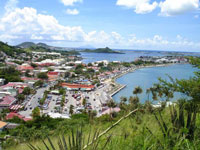
Marigot
A delightful mixture of France and the Caribbean, Saint Martin's capital city of Marigot is cluttered with shops and houses serving a permanent population of about 6,000. The town …
Marigot
A delightful mixture of France and the Caribbean, Saint Martin's capital city of Marigot is cluttered with shops and houses serving a permanent population of about 6,000. The town stretches along Marigot Bay, its main focus being the harbour at the bottom of Rue de la Republique from where ferries depart to surrounding islands and fishing boats come and go.
Originally a tiny fishing village, Marigot became the capital of Saint Martin during the sugar boom and quickly grew. Marigot's buildings are largely colonial in style, sprinkled with several smart cafes, bistros, pastry shops and luxury boutiques reminiscent of mainland French market towns. There are also several colonial landmarks, including Fort St Louis.
The main shopping centre in Marigot is at the southern end of the town near the harbour, which is a paradise for shopaholics, with boutiques stocking the latest designer fashions and jewellery, all tax-free. More adventurous shoppers will enjoy browsing the Wednesday and Saturday morning markets, located in a kiosk area near the port.
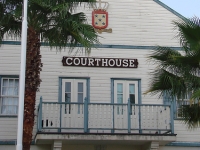
Philipsburg Voorstraat
The Voorstraat (Front Street) faces south onto the ocean and is the main tourist attraction in Philipsburg. At its eastern end is Wathey Square, just a minute's walk from the Great…
Philipsburg Voorstraat
The Voorstraat (Front Street) faces south onto the ocean and is the main tourist attraction in Philipsburg. At its eastern end is Wathey Square, just a minute's walk from the Great Bay Beach and two casinos: the Rouge et Noir and the Coliseum Casino. The impressive white wooden courthouse built in 1793 now serves as a post office, while just off the square is the quaint Methodist church built in 1851. Further along Voorstraat is a group of elegant colonial houses, as well as a small museum and two large marinas. Voorstraat is also known as the best shopping area in Philipsburg, boasting a number of jewellery stores and perfume boutiques taking advantage of the island's duty-free status.
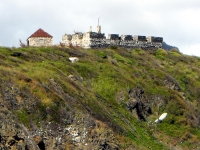
Historic Forts
The town of Philipsburg boasts the remains of two historic forts bearing witness to its one-time strategic importance to the Dutch. The first Dutch military establishment in the Ca…
Historic Forts
The town of Philipsburg boasts the remains of two historic forts bearing witness to its one-time strategic importance to the Dutch. The first Dutch military establishment in the Caribbean, Fort Amsterdam was built in 1631 on a peninsula between Great Bay and Little Bay, but it was captured almost immediately by the Spanish. The other Dutch fortification, Fort Willem, bears the crown of a television transmission tower. Both are worth the walk to visit, particularly for the beautiful views. Fort St Louis was built according to plans sent from France by Louis XVI in 1767 to guard the settlement from invaders. It's Saint Martin's largest historical monument and looks out over Marigot, the hilltop ruins offering gorgeous island panoramas.
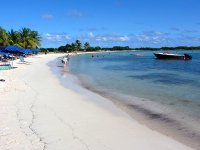
Sint Maarten Beaches
Sint Maarten's prime beach resorts extend from Philipsburg along the southwest coast of the island, reaching a grand finale at the great spread of Simpson Bay, site of the internat…
Sint Maarten Beaches
Sint Maarten's prime beach resorts extend from Philipsburg along the southwest coast of the island, reaching a grand finale at the great spread of Simpson Bay, site of the international airport. From the headland at the western end of Great Bay stretches the secluded Cay Bay. This quiet beach can only be reached by dirt road or horse trail. Simpson Bay Lagoon is surrounded by resort developments and enjoys a series of white sandy beaches. Maho Bay is Sint Maarten's largest resort, with well-developed facilities, a casino and its popular Sunset Bar. Mullet Bay is usually the most crowded, and is loved for its gentle surf and shady stretch of palm trees. Cupecoy is favoured by nudists, and has dramatic sandstone cliffs and caves.
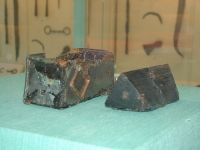
Marigot Archaeological Museum
Next to the Marina Port la Royale on the southern end of Marigot is an archaeological museum dedicated to preserving Saint Martin's history and culture. It houses numerous exhibits…
Marigot Archaeological Museum
Next to the Marina Port la Royale on the southern end of Marigot is an archaeological museum dedicated to preserving Saint Martin's history and culture. It houses numerous exhibits, such as a variety of pre-Columbian treasures and several interesting exhibitions on Arawak culture. There is also a reproduction of a 1,500-year-old burial mound and ceramics dating from 550 BC. The island's more recent history is encapsulated in evocative black and white photographs of quiet streets populated by a handful of children and donkeys, and of labourers toiling in the salt industry.
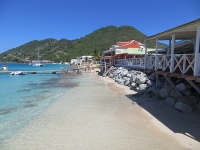
Grand Case
The little fishing village of Grand Case lies at the northern tip of Saint Martin, and is famed for the distinctive look of its small wooden houses, which are painted pastel colour…
Grand Case
The little fishing village of Grand Case lies at the northern tip of Saint Martin, and is famed for the distinctive look of its small wooden houses, which are painted pastel colours and are decorated with numerous elaborate embellishments, and its great cuisine. Many fine restaurateurs have chosen to congregate in the town's main street, which has become one of the best dining centres in the region and earned Grand Case the epithet 'Gourmet Capital of the Caribbean'. Visitors will find anything from French-driven cuisine to traditional Creole or Caribbean fare. Tuesdays are dubbed Harmony Nights, with live music and entertainment spilling out into the streets; the beaches are also lovely, with calm and safe waters that are ideal for refreshing dips.
Website www.grandcase.com
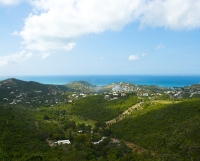
Paradise Peak
Paradise Peak, Saint Martin's highest point, rises from the centre of the island to a height of 1,390 feet (424m), and is crowned with a communications tower. Visitors can climb th…
Paradise Peak
Paradise Peak, Saint Martin's highest point, rises from the centre of the island to a height of 1,390 feet (424m), and is crowned with a communications tower. Visitors can climb through thick woods home to colourful birds and twisted vines, reaching a summit that provides spectacular views of the island and nearby Anguilla.
The Loterie Farm Nature Reserve nestles on the slope of Paradise Peak. The reserve has many miles of groomed hiking trails through beautiful forest, where visitors can spot local flora and fauna. Guided tours provide fascinating historical, cultural and scientific insights regarding the area, but the most popular attraction at Loterie Farm is the zipline, which is divided into three zones for children, adults and thrill-seekers. Visitors glide through the canopy between centuries-old mango and mahogany trees.
Website loteriefarm.com
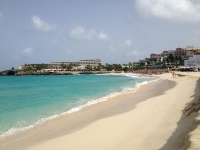
Saint Martin Beaches
There are a number of good beaches on the French side of the island that are very popular with tourists. Orient Beach, the largest and most popular in Saint Martin, is known for wa…
Saint Martin Beaches
There are a number of good beaches on the French side of the island that are very popular with tourists. Orient Beach, the largest and most popular in Saint Martin, is known for watersports, and borders a number of restaurants, beach bars and a nudist resort. Plum Bay is frequented by surfers while Rouge Beach offers great snorkelling and is regarded as the island's most beautiful beach. Long Beach has little shade and barely any breeze, while Le Galion Beach is the island's best windsurfing spot with shallow, calm waters. Anse Marcel is usually quiet and favoured by French tourists. Just north of Marigot, Friars Bay is backed by a lagoon, while nearby Happy Bay is beautiful and peaceful because it's relatively difficult to reach.
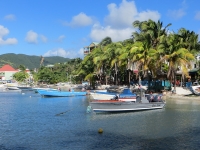
Philipsburg
Philipsburg is the capital of Dutch Sint Maarten. It has two main streets, Front Street (Voorstraat) and Back Street (Achterstraat), which as connected by several bustling thorough…
Philipsburg
Philipsburg is the capital of Dutch Sint Maarten. It has two main streets, Front Street (Voorstraat) and Back Street (Achterstraat), which as connected by several bustling thoroughfares and filled mainly with duty-free shops, cafes, hotels and courtyards overflowing with flowers.
The town enjoys an unusual setting on a narrow stretch of land between Great Bay on the south coast of the island, and the Great Salt Pond (a huge marsh). It is the port of call for hundreds of cruise ships, their daytripping passengers coming ashore to sample everything from Italian leather goods to local crafts and Philipsburg's lively nightlife.
Architecturally, the town, founded in 1763 by John Philips (a Scottish captain in the Dutch navy), is quaint, with characteristic pastel-coloured West Indian houses lining the streets, and a few Dutch colonial landmarks, including Fort Willem, built in 1801, and Fort Amsterdam, constructed nearly 200 years earlier in 1631.
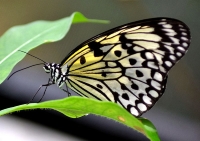
The Butterfly Farm
A popular family attraction in Sint Maarten, the Butterfly Farm is a large greenhouse housing more than 40 different varieties of butterflies and moths. Guests can take a guided to…
The Butterfly Farm
A popular family attraction in Sint Maarten, the Butterfly Farm is a large greenhouse housing more than 40 different varieties of butterflies and moths. Guests can take a guided tour explaining the lifecycle of the butterfly and its place in the ecosystem, with guides helpful in advising which plants will attract butterflies to your garden. Guests are free to handle and interact with the butterflies, and morning is the best time to visit the Butterfly Farm as new butterflies emerge from their cocoons. The farm is wheelchair accessible, and there are snacks and drinks available.
Website www.thebutterflyfarm.com


